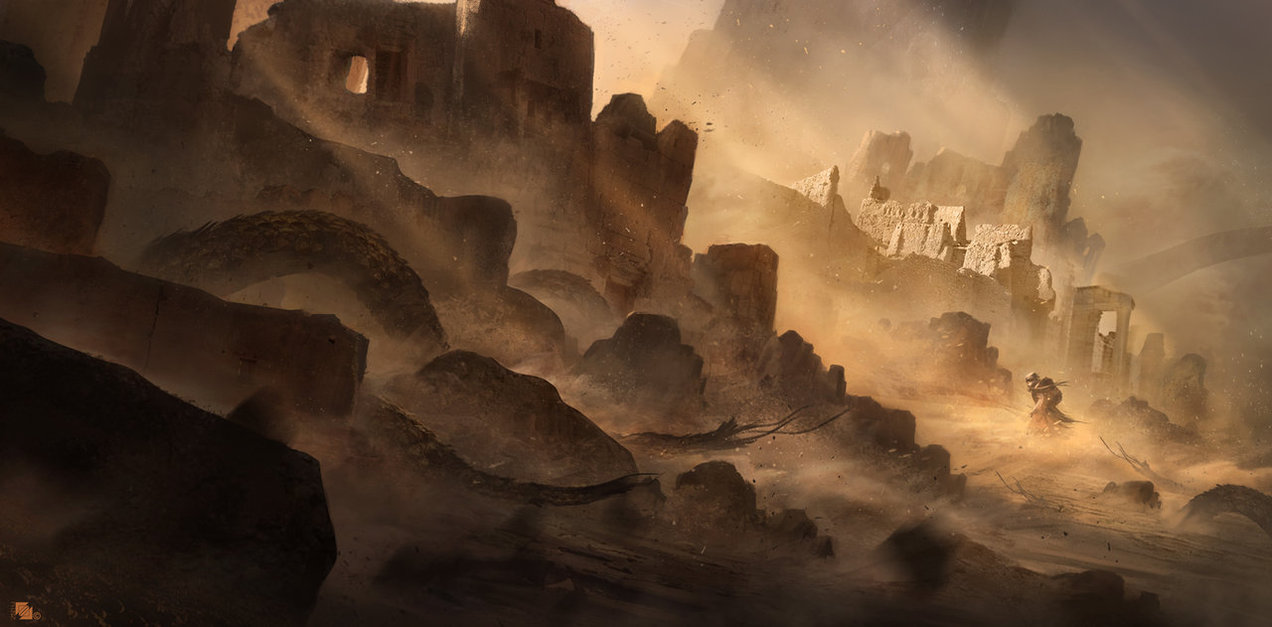Riqil and the Cup of Sunlight
Riqil beamed and laughed and cried with joy as he watched his plants bloom and blossom. They bore for him great glorious flowers and juicy glistening fruits. He was happy. They were happy. It was a moment he would always remember. But between his paws, a storm was brewing. The pewter cup grew hot. The sun could not be contained, not by a little cup. So it burst out with its heat and light, streaking into the sky. When the darkness came and the cold winds stirred, not one of Riqil's plants remained. There was only ash blowing away in the cold wind. Aqirim, who'd been watching from nearby, waiting for his share of sun, was livid at what he saw. He flew to where Riqil was mourning and pointed at Riqil with his claw. "Give me my sunlight!" said Aqirim. "I don't have it!" Riqil replied. "Then give back my pewter cup!" said Aqirim. "I don't have it!" said Riqil, for he couldn't have lied. And so it was that Riqil fled from the only home he'd ever known. Aqirim was close behind, claws outstretched, screeching. Riqil managed to hide in caves, but Aqirim would always find him. But never did Aqirim get his sunlight or his cup, and to this day his children search for repayment of the ancient debt in blood.The story of Riqil, from the Arventiri riqil meaning desert cat, is a children's story. It is set in a world very different from the "real" world, where one half of the world is shrouded entirely in darkness and the freezing cold, while the other is perpetually bright and happy. The fable follows the misadventures of Riqil, a desert cat who has somehow managed to cultivate a tiny garden with sentient plants. Riqil has been to the mountains at the "edge" of his world and has felt the warmth of the sun on his fur, so he seeks to obtain even just a droplet of that light and warmth for his poor plants.
Summary
Over the course of its history in the cultural backdrop of the Pāll-tanír, the story of Riqil has had a number of different iterations, with small aspects changing along with the identities and characterizations of the whole cast. It is known as the "Riqil" story because this is the most popular contemporary incarnation of the tale, but even a cursory examination of this fable and similar stories points out a handful of common features.
The story almost always begins with Riqil climbing up the side of the mountains at the "edge" of his world of cold and darkness only to find that the land beyond is filled with sunshine and happiness and warmth. This is considered symbolic of climbing out of adversity, such as poverty, or in the case of the Pāll-tanír, rising up out of the shadow cast by the old tussari centhiri empire of Mulrakh.
More often than not, the character of Riqil is described as reveling in the warmth of the light, not wanting to go back to his tiny little house in the middle of the freezing darkness. But invariably, the protagonist realizes that he does not want to abandon the plants that he had worked so hard to grow, and who depended on him to stay alive.
In a scene that is absent from some retellings but is typically used to justify Riqil's journey, Riqil returns to his hut and regales his plants with the story of the light and the warmth that he experienced at the top of the mountains. The plants are described as listening intently, but chattering and shivering because of the cold dark. This makes Riqil feel guilty, and is what sets him off on his journey as he promises that he will bring some of the sunlight back for his plants.
Following from this event, or from Riqil descending the mountain in the versions of the fable that lack the justification scene, one of Riqil's plants gives him a tiny withered leaf curled up in the shape of a bowl, something for him to carry the light of the sun in. Riqil climbs the mountains once again and tries to catch some sunlight in his little leaf, but the heat burns away the fragile little cup.
After his first failure, Riqil starts the journey back to his home dejectedly, but finds a bowl-shaped stone which he eagerly carries back up to the summit of the mountain. He manages to catch some of the sunlight in it, but it proves to be too heavy, and he drops it. The bowl rolls down the side of the mountain and spills the sunlight, wasting it.
Riqil then, for reasons that vary from one telling to the next, goes to a near-frozen river to harvest clay from its banks and from it crafts another bowl which he bakes in the heat of the sun. He catches a good amount of sunlight in his clay vessel, but he trips over a stone on his way back and it shatters against the ground, spilling sunlight again.
Then, the character of Riqil is visited by a particular figure. It varies from region to region, but it is almost always a bird of prey or the natural predator of whichever animal the character of Riqil is representing in a particular telling. In the common story of Riqil, this character is played by Aqirim, a predatory bird that hunts desert cats like Riqil.
Aqirim then offers Riqil a pewter cup, which allegedly would be able to contain the light of the sun, but only in exchange for Riqil giving a portion of the sunlight to Aqirim, who also lives in the dark side of the world. Riqil agrees and takes the cup before making a final ascent up the mountain.
As Riqil ascends the slopes for the last time, he realizes that he's tired of going up and down so much, and that he doesn't want to, anymore. He decides that if the cup could hold the sunlight, then sure it should be able to hold the sun. The sun wasn't that big, after all, and indeed, Riqil is able to pluck it from its lofty perch and slip it into his pewter cup, covering the top with his paw so as to hide the light from prying eyes.
He descends the mountains, noticing that the cup is getting hot, but paying it no attention. He brings it to his garden first, and shines it upon his plants. They drink in the sunlight and grow big and strong, bearing abundant flowers and glistening fruits, singing to him joyfully as they revelled in the warmth.
Riqil realizes too late that the cup is getting too hot, and before he can do anything, the sun bursts out, incinerating his entire garden, leaving him nothing but ash. In the popular telling of this story, the soot stains Riqil's front paws, explaining why desert cats have black footpads.
Aqirim, who has been watching from nearby, is furious at Riqil and demands his portion of the sunlight. Riqil, having not had a moment to grieve for his garden, says that he doesn't have it. Aqirim demands his cup back. Riqil says that it has melted. When he sees the murderous glint in Aqirim's eye, he flees. And as the popular telling goes, Aqirim's descendants hunt Riqil's to this day, demanding either their cup back, or their portion of sunlight.
Spread
The fable of Riqil and the cup of sunlight is widespread in the Pāll-tanír, crossing even racial barriers as there are recorded instances of the story being told among different ethnic sub-groups of the veldrani, khathari, alossi centhiri, a'drekh, and arventiri.
There are no extant records of the tussari centhiri having equivalent folklore, so it is believed that the story of Riqil originates from, at the earliest, the formation of the Krosha, and at the latest, the genocide of the highborn. The imagery and symbolism of the first part of the story, particularly, strongly point to a culture that has just emerged from "darkness" into the light.
Variations & Mutation
The story of Riqil tends to vary with geographic location, with ethnic groups closer to the center of the continent maintaining a relatively stable narrative with few changes in between. Ethnic groups further away from the heart of the continent, however, such as the Kastaen have significantly different versions of the story, but the main elements remain mostly intact between even these different tellings.
One version of the story, in particular, popularized in the tent-city of Dkhotelai in Kasta in the early seventh century of the 29th millennium NL departs from the notion of a world half in darkness and a world half in light. In this telling, the mountains that form the edge of Riqil's world are noticeably absent. Instead, the world below is dark, while the heavens above are bright with sunlight, and Riqil climbs a tall pole to catch the sun in his cup.
The elements that remain largely unchanged between different iterations of the story are the fact that Riqil lives in a dark world and has had his first taste of a world where things aren't as bad, Riqil failing three times to catch the sun using a vessel made from plant-matter, from stone, and from clay, and succeeding a fourth time with a vessel made of metal given to him by a "friend." The results of Riqil's "success" are also relatively invariant between different tellings, and although the consequences differ in the details, Riqil's greed ends with some sort of personal tragedy.
Cultural Reception
Although not vital to the cultural identity of any of the ethnic groups that tell his story, Riqil is nevertheless a valuable fable used to teach certain lessons of morality to children. The interpretation varies from group to group, but among the most popular is the notion that when good fortune befalls a person, through hard work and perseverance, it is important to not keep it all to oneself, but instead spread out the goodness so that all people have a chance to experience the "light" for once.
In Literature
The story of Riqil has inspired many works since its inception and it has served as the cornerstone of many classical works of literature. In tragedies from the Pāll-tanír, for instance, the pattern of three failures and a fourth success that leads only to misery is a well-known trope and is one of the most popular ways of telling a story.
Beyond that, the story of Riqil has inspired numerous philosophical treatises as to whether Riqil was wrong to obtain the sun. The question of whether Riqil was acting selfishly or selflessly is one that is often raised and is considered a very important point in the discussion of the morality of Riqil's actions. On the other side of this, the story of Riqil has inspired a second body of philosophical works that examines whether it is correct to condemn the actions of Aqirim, and whether he is justified in pursuing Riqil for his cup and his share of sunlight.
It is this latter body of works that inspired well-known author Zariyya ar'Hakabb to write her seminal work "A Misunderstood Creature," which remains a contentious piece of literature to the modern day.
Date of First Recording
Roughly around the time of the Krosha
Date of Setting
Unknown
Related Species





I loved your story! It's very well crafted and even "explains" nature features like riqils' coloration and predators. And this ending where the sun basically explodes his plants is also very strong, I think. Good job : )